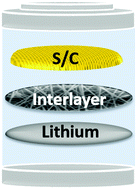The adsorption effect of freestanding SiOx-decorated stabilized polyacrylonitrile interlayers in lithium–sulfur batteries†
Abstract
Lithium–sulfur batteries are well-known for their high theoretical specific capacity and high energy density. However, they undergo rapid capacity fading after the initial cycles due to the dissolution of polysulfides which further results in the shuttle effect. To address this issue and to protect the Li anode surface, silicon suboxide decorated stabilized polyacrylonitrile (sPAN-SiOx) fibermats are used as a freestanding interlayer on the cathode side. Polysulfides are easily captured at the cathode side with the help of the complementary adsorption effect of oxygen-containing functional groups, SiOx and the pyridinic-N structure of sPAN-SiOx resulting in better electrochemical cell performance. The adsorption effect of those functional groups and SiOx is confirmed by X-Ray Photoelectron Spectroscopy (XPS) analysis as obvious shifts in the binding energies and reductions of the peak intensities in the presence of polysulfides. The battery cell with the sPAN-SiOx interlayer shows a discharge capacity of 646 mA h g−1 after 100 cycles of charge–discharge at C/5 current density which is a significant increase compared to the cells with a stabilized polyacrylonitrile (sPAN) interlayer or the cells without an interlayer.



 Please wait while we load your content...
Please wait while we load your content...